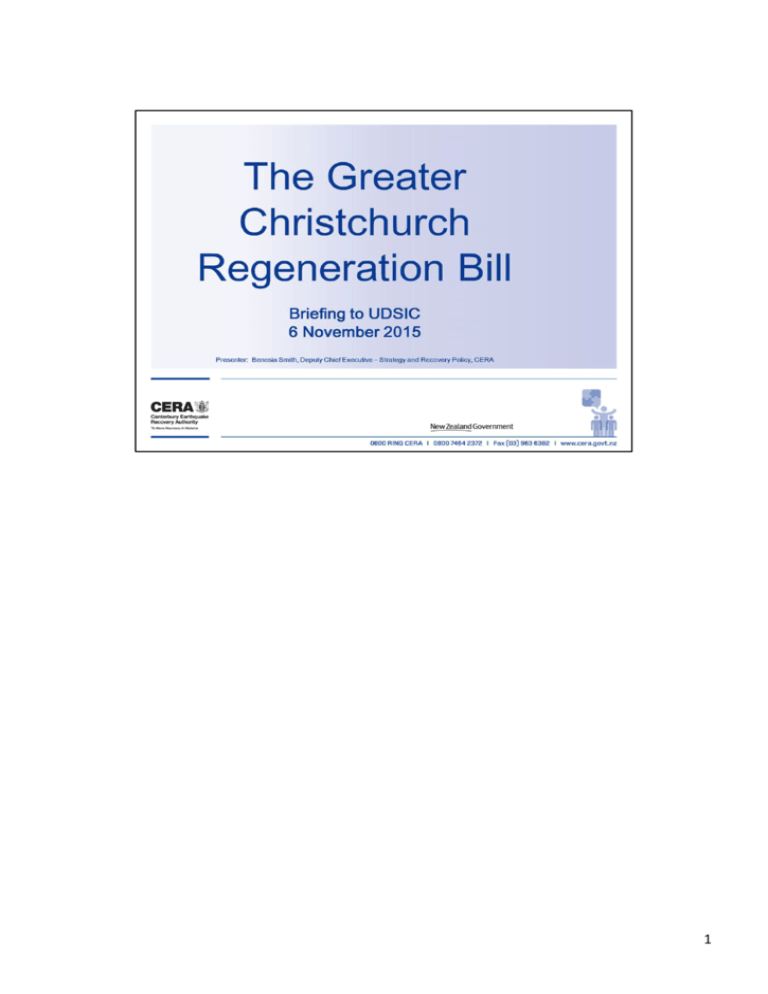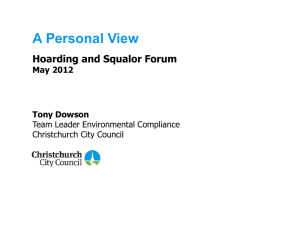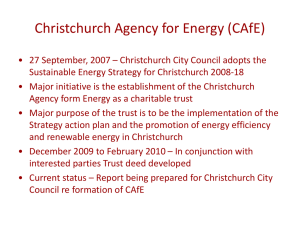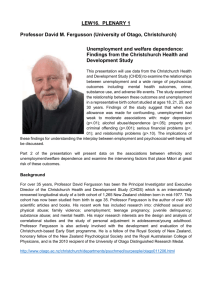Presentation on the Greater Christchurch Regeneration Bill, by
advertisement

1 The key topics to cover today Noting can’t talk about some elements of the policy decisions behind the Bill as it is with the Select Committee. The Bill is what the Bill is. 2 Reminder of the context and our representation of the four phases of recovery: emergency response, recovery, regeneration and setting a vision for the future. The diagram has been adapted from work developed by Jo Da Silva OBE, Director, Arup International Development. Jo’s model was adapted from an earlier model developed by the UN Development Programme Policy on Early Recovery. • Overlapping phases rather than moving from one to the next. While there is some restoration left to do – completing housing and infrastructure repairs – the focus is now regeneration. The next five years: 2016 – 2021 • CER Act expires in 2016. New legislation is needed to support regeneration that will continue after the CER Act expires – but the new Bill will have fewer powers and more local input on use 3 • Psychosocial recovery and restoring the community’s sense of wellbeing is still not complete; the most difficult phase still has a couple of years to run. (We count the years form the last “big” earthquake which occurred in December 2011. This means we are now only on year three moving into year four.) • Collaboration between central and local government is still needed to effect a positive recovery • By 2021, the aim is that the Crown will have returned to a normalised relationship with the Strategic Partners and greater Christchurch communities, that is: • Departments will be delivering any remaining recovery-related services as business as usual • Councils will be making their usual decisions • Regenerate Christchurch, which is covered in more detail later in this presentation, will become entirely council-controlled • The Crown’s special role will be limited to the run-out of the last few pieces of public sector rebuild Transition Recovery Plan The final Transition Recovery Plan was released on 22 October 2015. A copy of the Ministerial Decision Paper, the Cabinet paper and the Cabinet Minute are available on the CERA website. In addition, a copy of all written comments received and the summary of written comments is also available on the CERA website. 3 • The Bill is a new piece of legislation, not simply a carry-over of the CER Act. Local leadership - One of the key aims of the Bill is to signal the transition towards local leadership over the next five years. Reduced geographical scope - map on the slide shows that the area subject to this Bill is substantially smaller than under the CER Act. When the Bill was being developed aspects of the CER Act, such as geographical boundaries were examined to see if they should be changed. Legislation to expire in June 2021 - The Bill is proposed to expire on June 2021. It is just over 5 years because this is the time estimated to ensure the momentum and when it is expected to make significant progress in regenerating greater Christchurch, particularly the central city and red zones. 4 Retains some powers to continue recovery work and regeneration -Part of the legislation does include powers similar to the CER Act, such as the ability to compulsory acquire land. This is needed to address earthquake recovery in areas like the Port Hills. 4 5 • Broadly the Bill has six main parts: 1. Preliminary provisions (including purpose) 2. Planning provisions, such as the ability to develop Regeneration plans 3. Building/works provision (including access and roads, directing owners to act) 4. Acquisition and other dealing with property (includes amalgamation and subdivision) 5. Compensation and appeal rights 6. Establishment of Regenerate Christchurch • There are also transitional provisions e.g. savings and repeals of Orders in Council in the Schedules The is presentation looks at more detail at: • Powers of the responsible Minister and CE’s of government departments • New public engagement processes • Regenerate Christchurch • Planning provisions The as signalled, finish with an overview of where we are in the Bill process 6 Bringing together the Bill’s Planning Powers and the Role of Regenerate Christchurch and Strategic Partners Regeneration Plans • The Bill provides for the ability to develop Regeneration Plans, and amend or revoke existing Regeneration Plans (or Recovery Plans created under the CER Act) for regeneration purposes. Similar to Recovery Plans Power to suspend or revoke planning documents • This power enables specific changes to be made to relevant RMA plans and LGA bylaws for regeneration purposes. Similar to the current Section 27 CER Act powers. 7 Consultative process – as signalled , specific consultation with Strategic Partners • Proposals to exercise either of these powers can be developed by strategic partners, Regenerate Christchurch a Responsible entity or the Minister. (Responsible entities can be a council organisation, a chief executive, an instrument of the Crown or a Crown entity.) • Strategic Partners, Regenerate Christchurch must then be consulted. (Regenerate Christchurch to comment on its areas of focus) • Draft Plans or amendments must be made available for public comment by proponents. The Minister invites public comment on the use of the power to suspend, amend or revoke planning documents. • The Minister must have particular regard to the views of strategic partners and Regenerate Christchurch when making the decision to exercise either of these powers. Next slides cover in detail: • Summary of Planning Powers • flow process for making or amending regeneration Plans 7 8 9 10 11 12 13 • The Bill establishes Regenerate Christchurch - a bespoke joint Council/Crowncontrolled entity. It will transition to full Council control at the expiration of the new legislation. It will be a new type of entity, with provisions based on Crown Entities Act 2004 but also mindful of the Local Government Act requirements for council controlled organisations. Recognise that for the City Council, Regenerate Christchurch is a Council entity with a 30 year horizon – hence successor council organisation in 2021. Also details of operation set out in Schedule 5 of the Bill have strong City Council interest (e.g. reporting and audit cycles) • Regenerate Christchurch is not CERA’s successor, the entity supports regeneration though interacting with other agencies including: • CrownCo – a Crown company set up to deliver certain Crown led projects • Development Christchurch Limited – the Council company which will delivery council led projects • The Bill does not give Regenerate Christchurch any decision-making powers over land use or works powers or planning powers etc. • The chief executive of Regenerate Christchurch does not have the powers of the chief executive under the Bill – because the chief executive powers only 14 relate to departments of state – which Regenerate Christchurch is not. • Regenerate Christchurch cannot directly access the special powers in the Bill. These powers can only be exercised by a Minister of the Crown or, a chief executive of a government department as determined by the Prime Minister. • It will have 7 board members (under the bill), 3 appointed by Christchurch City Council and 3 appointed by the Minister. The seventh member will be appointed by the Minister following consultation with Te Rūnanga o Ngāi Tahu. • Schedule 4 lists the geographic areas that Regenerate Christchurch will focus its activities on, with new areas being able to be added by Order in Council. Q and A: if required Q: Why are there three boxes? A: Our fundamental answer is that this delivers on both the demands of transition, and regeneration. One entity was considered, in which the Council and Crown’s interests in both regeneration and delivery would be combined. However, one entity also poses some difficult and challenging issues – very different skill sets required at the board level, the distraction that the major projects would pose for the board in terms of the attention given to these at the expense of its regeneration functions. A single jointly governed entity responsible for anchor projects would also be more complex to establish and make transition more difficult. Q: What will the Crown company do and how long will it last? A: It will deliver projects within expected time, cost and quality constraints, Potentially undertake divestment activities for land and anchor project structures to optimise the returns to the Crown. It will have a low public profile in comparison to Regenerate Christchurch. It’s job is to deliver and wind down Q: what is the relationship between the three? A: (also covered a bit in the next slide) Each will have their own board – there is no formal relationship between the entities – no power to direct, Development Christchurch, CrownCo are not subsidiaries of Regenerate Christchurch. Each entity has a complementary role to play in regeneration. The formal relationship is through the owners/shareholders. There will be tools to establish ways of working and set expectations including Letters of Expectations, Statements of Intent etc. Q: who will hold the assets? A: Subject to further consideration/decisions but thoughts are: Crown Company could hold: • anchor project assets; • on request, precinct land for which development opportunities 14 have arisen and been approved by the Board Regeneration Christchurch would not hold assets beyond working capital Land Information New Zealand will manage the Red Zone Land on behalf of the Crown until a decision about future use are made (It stays on the Crown’s books) via a Regeneration Plan which Regenerate Christchurch will lead. Background/History In June, Minister for Canterbury Earthquake Recovery and the Mayor of Christchurch resolved to work together to investigate establishing an entity(s), possibly named “Regenerate Christchurch”, to deliver and develop the Crown and City Council’s objectives for the regeneration of Christchurch City. Specifically: - the objectives and functions of an entity (including its relationship, and possible integration, with Development Christchurch Ltd), its capital and operating cost requirements, funding options, geographical scope, and powers under any new legislation that might be required for the entity to operate efficiently and effectively - membership of the “Regenerate Christchurch” Board and appointments (including the relationship of the Board with the relevant Minister and Mayor of Christchurch), and how responsibility for appointments will progressively transfer to the Christchurch City Council - the timeframe for how long “Regenerate Christchurch” might be in existence - the set-up of an Establishment Board and its members, scope and functions 14 • There is no formal relationship between Regenerate Christchurch and the Crown company. • Along with Christchurch development Limited the three entities have a common focus on regeneration; but, each operates independently. There is no legal relationship between these organisations and one cannot require another to act. Regenerate Christchurch Seen as more of a coordinating body, rather than project delivery Recognise that from the City Council, Regenerate Christchurch is a Council entity with a 30 year horizon – hence successor council organisation in 2021 Details of operation have strong Council interest (e.g. reporting and audit cycles Current process re establishment includes: • An establishment process jointly supported by CCC and Crown officers/officials • establish a Heads of Agreement between Christchurch City Council and Crown to guide the way in which the two owners of the entity will work together • Start working on the joint letter of expectations which is the means by which the Council and Crown will provide the Entity with its priorities and guide its Statement of Intent. [Note similar process to a CCO developing its Statement of Intent under the Local Government Act] • Also agree on funding of operational costs and develop governance and 15 accountability arrangements (50:50 shared funding) • Confirm Chair –designate and other board members • Reminder – the Bill needs to be an Act for this entity to be formally and legally established A crucial first step is appointment of a chair designate, who would then drive an establishment process which was jointly supported by CCC and Crown oversight group. It would include finding a CEO designate. The RC establishment process should have links to establishment work for Crown Co and DCL but would be discrete. Crown company: CrownCo is the provisional name for the Crown company that will deliver defined anchor projects in Christchurch and manage and divest defined parcels of land owned by the Crown. New legislation is not required to establish CrownCo and it cannot use the powers under the Bill. Ross Butler: presently the chairman of Southern Response, the Crown company set up to manage the insurance claims of AMI policy holders in the wake of the Canterbury earthquakes. He also took on the initial chair role for the Code Committee (Financial Advisers Act) in the wake of finance company failures. And also chairman of Nelson Marlborough Institute of Technology, Rangitane Holdings Limited and Rangitane Investments Limited, Mercer New Zealand and Mercer Investments Australia Pty Ltd, the Australian arm of New York listed global services group Marsh & McLennan What is Development Christchurch Limited (previous slide)? Development Christchurch is a Council Controlled Trading Organisation operating under Christchurch City Holdings Limited. The focus of the company will be on generating investment opportunities, allowing for the long-term regeneration of central and wider Christchurch. 15 16 The Bill was introduced to Parliament on 19 October 2015, and had its first reading speech and debate on 22 October 2015. The Bill passed its first reading with unanimous support. The Bill has been sent to the Local Government and Environment Select Committee for consideration over the next four months. The Select Committee has invited public submissions on the Bill. The closing date is December 4. We anticipate there will be hearings based in Christchurch, this will be confirmed by the Select Committee in due course. Under current timelines, the Select Committee is aiming to report back to Parliament on the 25 February. More information on the Select Committee Process and how to make a submission can be found on www.parliament.nz Parliamentary privilege operates during the select committee process. Although hearings will be in public, CERA officials are not able to discuss the committee’s deliberations with submitters. 17







